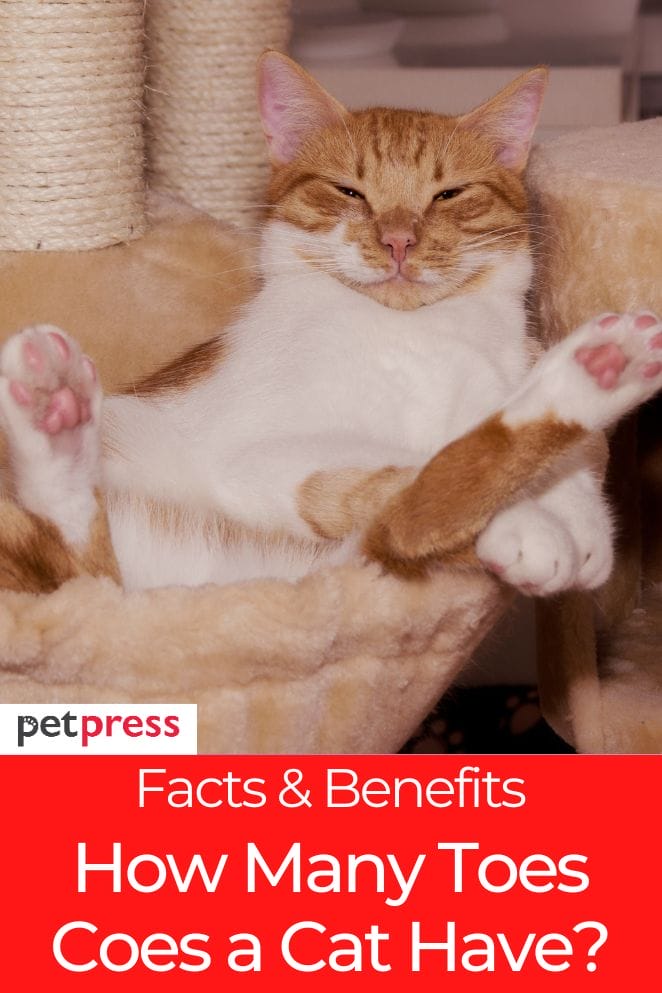
Cats are some of the most adored and beloved creatures in the world.
They provide us with companionship, love, and entertainment – but how many toes does a typical cat have?
Believe it or not, cats actually have quite a few toes!
In this article, we’ll explore just how many toes a cat has and other interesting facts about their paws. Read on to learn more about cats and their toe count!
How many toes a cat typically has?

Cats typically have 18 toes, with five on each front paw and four on each back paw.
The front paws of a cat are known as polydactyls, which means they have an extra digit or “toe” compared to other animals.
These toes help cats balance better while walking and leaping, making them extremely agile predators.
Cats also have sharp, curved claws on each toe that they use to climb and protect themselves.
A cat’s back paws contain four toes which are shorter and smaller than the front ones but equally as important for providing balance.
All of a cat’s toes give them extra grip when walking across slippery surfaces such as tiles or wooden floors.
So, the answer to how many toes a cat typically have is 18.
Why do cats have so many toes?
Cats evolved from the ancient felines of Africa, known for their impressive balance and agility.
The extra toe on each front paw provides extra balance while they walk and leap, allowing them to get better traction on slippery surfaces.
The extra toe also helps cats grip things such as branches or fences when they climb or jump.
This is an important adaptation that has helped cats survive in the wild for thousands of years.
What are the benefits of having extra toes?

The extra toe on cats may have many benefits, including:
Improved balance and agility
The extra toe on cats helps them have better balance and agility when walking, running, jumping, or climbing.
Cats can move quickly and accurately because of their extra toes, making them formidable predators in the wild.
Improved grip for slippery surfaces
Cats’ extra toes also give them extra grip when walking on slippery surfaces such as tiles or wooden floors.
This helps cats stay safe and prevent slipping when navigating wet, slick areas.
Ability to grab onto things better
Cats’ extra toes give them an additional way to grab and hold onto things.
This is especially helpful for cats when climbing or jumping, as the extra toe provides an extra grip point that helps them keep their balance and stay secure.
Enhanced survival capabilities in the wild
The extra toe on cats helps them survive better in the wild, giving them an additional way to hunt, climb, and protect themselves.
This adaptation is crucial for cats living in precarious environments, where balance and agility can differentiate between life and death.
Increased dexterity and flexibility when reaching out with front paws
The extra toe on cats also allows them to reach out farther and more precisely with their front paws.
This helps cats catch prey or explore objects without moving their entire body, giving them a distinct advantage in the wild.
Some Interesting facts about cat toes

Fact #1: Cats have 18 toes in total
Cats have 18 toes in total, which includes five on each of their front paws and four on the back ones. This gives cats an extra digit compared to other animals, known as polydactyl.
Cats’ 18 toes give them extra balance when walking or leaping and improved grip when climbing or jumping.
They also provide cats with increased dexterity and flexibility when reaching out with their front paws, making them more agile and capable hunters in the wild.
Fact #2: Cats’ claws are curved for climbing
Cats’ claws are curved to help them climb trees and other surfaces with ease.
This helps cats stay safe and secure when navigating slippery or vertical terrains, as the curve of their claws allows them to grip better and hold onto branches or rocks.
The curved shape also makes it easier for cats to catch prey, as they can more easily pierce through fur or skin to disable their target.
Fact #3: The extra toe helps cats hold onto their prey
The extra toe on cats’ front paws helps them better grip and hold onto their prey.
The added digit gives cats an additional way to grasp, making it easier to keep a tight grip and not let go.
This is especially helpful for cats in the wild, as it gives them an extra way to ensure they can keep their target close until they’re ready to strike.
Final thoughts
The extra toe on cats provides them with a distinct advantage when it comes to navigating their environment and hunting for prey.
This adaptive feature helps cats stay safe, balanced, and agile, giving them an edge in the wild and helping them stay one step ahead of danger.
With their 18 toes (including the special polydactyl toe), cats have the tools they need to survive and thrive in any environment.


GIPHY App Key not set. Please check settings